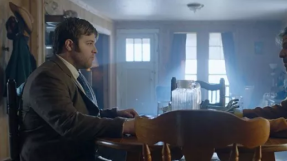
The Smithsonian Channel shows in the first episode of its documentary series "Secrets" the emergence of new "very compelling" evidence that the Tower of Babel, as mentioned in the book of Genesis in the Old Testament, actually existed.
An illustration of the Old Testament Tower of Babel, as part of a promotional video for the Montreat Conference Center's 2017 College Conference."Biblical scholars have long debated whether the Tower of Babel really existed. Now, a remarkable stone tablet never before shown on film appears to settle that question," the Smithsonian magazine says, featuring the video on its website.
The tablet, which dates to about 600 B.C., is from the private collection of Norwegian businessman Martin Schøyen, and it includes the clearest image ever found of the Great Ziggurat of Babylon, according to Andrew George, professor of Babylonian history at the University of London, who also says in the video that it carries an illustration which looks like a pyramid-like structure, with a depiction of King Nebuchadnezzar II, the ruler of Babylon from 605-562 B.C.
Genesis 11:4 says, "Come, let us build ourselves a city and a tower with its top in the sky, and so make a name for ourselves; otherwise we shall be scattered all over the Earth."
The following verses state: "But the Lord came down to see the city and the tower the people were building. The Lord said, "If as one people speaking the same language they have begun to do this, then nothing they plan to do will be impossible for them. Come, let us go down and confuse their language so they will not understand each other. So the Lord scattered them from there over all the Earth, and they stopped building the city. That is why it was called Babel — because there the Lord confused the language of the whole world. From there the Lord scattered them over the face of the whole Earth."
The Schøyen Collection says on its website that the ziggurat in Babylon was originally built around the time of Hammurabi 1792–1750 B.C. "The restoration and enlargement began under Nabopolassar, and was finished after 43 years of work under Nebuchadnezzar II, 604-562 B.C."
It adds, "Here we have for the first time an illustration contemporary with Nebuchadnezzar II's restoring and enlargement of the Tower of Babel, and with a caption making the identity absolutely sure. We also have the building plans, as well as a short account of the reconstruction process. The text also mentions the restoration of the E-ur-imin-anki ziggurat in Borsippa, once believed by some scholars to be the Tower of Babel."
It goes on to explain the text mentioning Nebuchadnezzar mobilizing workforces from all over the then known world to complete the Tower of Babel, people speaking a confusion of all the known languages at the time, raises a question.
"Did God really come down from Heaven to Earth to interfere in a building enterprise by creating language confusion as stated in the Bible? The account in Genesis 11 could, according to the text, have an entirely different and practical background: Obviously all the tens of thousands of workers speaking different languages could not communicate with each other, and this caused a total confusion at this huge building project, which lasted 43 years.
"Neither the Babylonian gods nor Yahweh needed to come down from Heaven to interfere and cause language confusion. And most importantly, the Jews taken into captivity in 586 B.C. after destruction of Jerusalem were there in Babylon and observed the building of the Tower and the confusion. So, when the Genesis text was composed by the Jews during the Babylonian exile and after return to their homeland in 539 B.C., this down to Earth chaotic building story had to be put in a theological context, and hence the present text in Genesis 11:1–9. Also note the link to Acts 2 where the Holy Spirit reverses the language confusion and makes everyone understand each other."
This article was originally published in The Christian Post.













